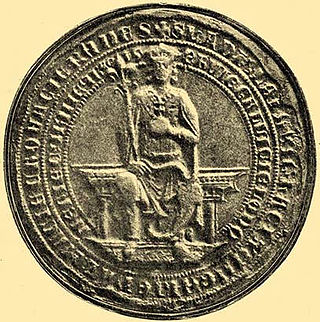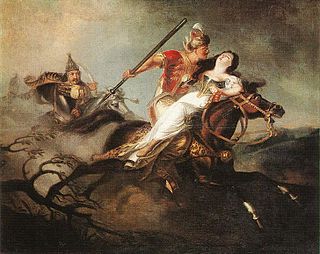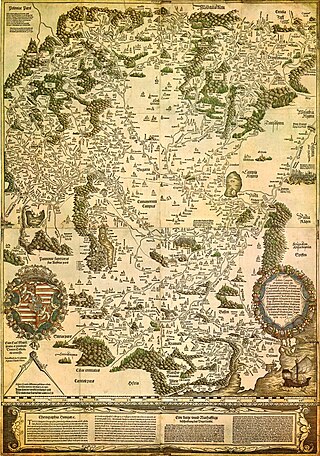Related Research Articles

Basarab I, also known as Basarab the Founder, was a voivode and later the first independent ruler of Wallachia who lived in the first half of the 14th century. Many details of his life are uncertain. Although his name is of Turkic origin, 14th-century sources unanimously state that he was a Vlach (Romanian). According to two popular theories, Basarab either came into power between 1304 and 1324 by dethroning or peacefully succeeding the legendary founder of Wallachia, Radu Negru, or in 1310 by succeeding his father, Thocomerius.

Ladislaus IV, also known as Ladislaus the Cuman, was King of Hungary and Croatia from 1272 to 1290. His mother, Elizabeth, was the daughter of a chieftain from the pagan Cumans who had settled in Hungary. At the age of seven, he married Elisabeth, a daughter of King Charles I of Sicily. Ladislaus was only 10 when a rebellious lord, Joachim Gutkeled, kidnapped and imprisoned him.
Taksony was the Grand Prince of the Hungarians after their catastrophic defeat in the 955 Battle of Lechfeld. In his youth he had participated in plundering raids in Western Europe, but during his reign the Hungarians only targeted the Byzantine Empire. The Gesta Hungarorum recounts that significant Muslim and Pecheneg groups settled in Hungary under Taksony.

Gesta Hungarorum, or The Deeds of the Hungarians, is the earliest book about Hungarian history which has survived for posterity. Its genre is not chronicle, but gesta, meaning "deeds" or "acts", which is a medieval entertaining literature. It was written in Latin by an unidentified author who has traditionally been called Anonymus in scholarly works. According to most historians, the work was completed between around 1200 and 1230. The Gesta exists in a sole manuscript from the second part of the 13th century, which was for centuries held in Vienna. It is part of the collection of Széchényi National Library in Budapest.
In Christian tradition, the seven heavenly virtues combine the four cardinal virtues of prudence, justice, temperance, and fortitude with the three theological virtues of faith, hope, and charity.

Glad was the ruler of Banat at the time of the Hungarian conquest of the Carpathian Basin around 900 AD, according to the Gesta Hungarorum. The Gesta, which was written by an author known in modern scholarship as Anonymus in the second half of the 12th century or in the early 13th century, is the earliest extant Hungarian chronicle. The Gesta did not refer to the enemies of the conquering Hungarians, who had been mentioned in earlier annals and chronicles, but wrote of a dozen persons, including Glad, who are unknown from other primary sources of the Hungarian Conquest. Therefore, modern historians debate whether Glad was an actual enemy of the conquerors or only a "fictitious person" made up by Anonymus. In Romanian historiography, based on the mention by Anonymus some 300 years later, Glad is described as one of the three Romanian dukes who ruled a historical region of present-day Romania in the early 10th century.

Bogdan I, or Bogdan the Founder, was the first independent ruler, or voivode, of Moldavia in the 1360s. He had initially been the voivode, or head, of the Vlachs in the Voivodeship of Maramureș in the Kingdom of Hungary. However, when the first certain record was made of him in 1343, he was mentioned as a former voivode who had become disloyal to Louis I of Hungary. He invaded the domains of a Vlach landowner who remained loyal to the king in 1349. Four years later, he was again mentioned as voivode in a charter, which was the last record of his presence in Maramureș.

Mary of Hungary, of the Árpád dynasty, was Queen of Naples by marriage to King Charles II. She was a daughter of Stephen V of Hungary and his wife Elizabeth the Cuman. Mary served as regent in Provence in 1290–1294 and in Naples in 1295–96, 1296–98, and 1302, during the absences of her husband.
The Roman Catholic Diocese of Cumania was a Latin-rite bishopric west of the Siret River from 1228 to 1241. The lands incorporated into the diocese had been dominated by the nomadic Cumans since about 1100. Catholic missions began after Andrew II of Hungary granted Burzenland to the Teutonic Knights in 1211. After Andrew expelled the Knights from the territory in 1225, Dominican friars continued the Cuman mission. Robert, Archbishop of Esztergom baptized Boricius, an influential Cuman chieftain, two years later.
The founding of Wallachia, that is the establishment of the first independent Romanian principality, was achieved at the beginning of the 14th century, through the unification of smaller political units that had existed between the Carpathian Mountains, and the Rivers Danube, Siret and Milcov.
The founding of Moldavia began with the arrival of a Vlach (Romanian) voivode, Dragoș, soon followed by his people from Maramureș, then a voivodeship, to the region of the Moldova River. Dragoș established a polity there as a vassal to the Kingdom of Hungary in the 1350s. The independence of the Principality of Moldavia was gained when Bogdan I, another Vlach voivode from Maramureș who had fallen out with the Hungarian king, crossed the Carpathians in 1359 and took control of Moldavia, wresting the region from Hungary. It remained a principality until 1859, when it united with Wallachia, initiating the development of the modern Romanian state.

The Kingdom of Hungary came into existence in Central Europe when Stephen I, Grand Prince of the Hungarians, was crowned king in 1000 or 1001. He reinforced central authority and forced his subjects to accept Christianity. Although all written sources emphasize only the role played by German and Italian knights and clerics in the process, a significant part of the Hungarian vocabulary for agriculture, religion, and state matters was taken from Slavic languages. Civil wars and pagan uprisings, along with attempts by the Holy Roman emperors to expand their authority over Hungary, jeopardized the new monarchy. The monarchy stabilized during the reigns of Ladislaus I (1077–1095) and Coloman (1095–1116). These rulers occupied Croatia and Dalmatia with the support of a part of the local population. Both realms retained their autonomous position. The successors of Ladislaus and Coloman—especially Béla II (1131–1141), Béla III (1176–1196), Andrew II (1205–1235), and Béla IV (1235–1270)—continued this policy of expansion towards the Balkan Peninsula and the lands east of the Carpathian Mountains, transforming their kingdom into one of the major powers of medieval Europe.

Pilis Abbey was a Cistercian monastery in the Pilis Hills in the Kingdom of Hungary. It was founded in 1184 by monks who came from Acey Abbey in France at the invitation of Béla III of Hungary. It was dedicated to the Virgin Mary.

Robert was a French-born prelate in the Kingdom of Hungary in the first decades of the 13th century. He was Archbishop of Esztergom between 1226 and 1239 and Bishop of Veszprém from 1209 till 1226. He played a decisive role in the establishment of the short-lived Diocese of Cumania. He was sharply opposed to the employment of Jews and Muslims in the administration of the royal revenues. He even put Hungary under interdict to force Andrew II of Hungary to dismiss his non-Christian officials.

The Monastery Church, also known as the Church of the Dominican Monastery, is a Gothic church formerly part of a medieval Dominican monastery in Sighișoara, Romania. The monastery was erected in 1289, and demolished in 1888. The monastery was one of a network planned by Paulus Hungarus throughout the Kingdom of Hungary to act as a bulwark against heresy. Hungarian nobleman Leonard Barlabássy gave the church an endowment.

The Battle of Kerlés also known as the Battle of Cserhalom, was an engagement between an army of Pechenegs and Ouzes commanded by Osul and the troops of King Solomon of Hungary and his cousins, Dukes Géza and Ladislaus, in Transylvania in 1068. The Pechenegs had been the dominant power of the westernmost regions of the Eurasian steppes since around 895. However, large Pecheneg groups moved to the Balkan Peninsula at the same time as the westward migration of the Ouzes and Cumans in the 1040s. The first recorded Pecheneg invasion of Transylvania occurred during the reign of Stephen I of Hungary.

The coinage in the Kingdom of Hungary started during the reign of Stephen I who was crowned the first king of Hungary in 1000 or 1001.
The freemen's pennies or the pennies of freemen was a direct tax in the Kingdom of Hungary in the 11th-13th centuries.

The timeline of Hungarian history lists the important historical events that took place in the territory of Hungary or are closely connected to the history of the country. The subsequent events encompass the timeline spanning from Classical Antiquity through the High Middle Ages, specifically up to the 1030s.
Bortz, also Boricius, was a Cuman chieftain in the 13th century. He voluntarily converted to Christianity in 1227, acknowledging the suzerainty of the Kingdom of Hungary. Within a year, the Roman Catholic Diocese of Cumania was established in Bortz's land along the river Siret in present-day Romania.
References
- ↑ Ullmann 2009, p. 149.
- ↑ Bejczy 2011, p. 227.
- ↑ Frantzen 1996, p. 463.
- ↑ List 1998, p. 56.
- ↑ Bejczy 2011, pp. 225–227.
- ↑ Berend et al 2013, p. 360.
- ↑ Tierney 1962, p. 54.
- ↑ Spinei 2012, p. 420.